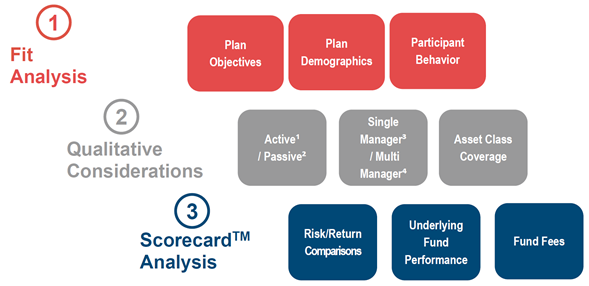While TDFs represent a growing share of retirement plan assets, these investments have a high degree of variability and are commonly misunderstood.
Given the importance of this unique asset class, fiduciaries must take the necessary steps to ensure proper selection, due diligence and documentation.
- Uncovers the best-fit glidepath by examining a plan’s demographics, objectives, and participant behavior
- Identifies a prudent target date series using our leading Scorecard criteria
- Allows for a consistent, repeatable, documented process to determine and defend QDIA decisions
TDF Evaluation Methodology
A TDF is largely defined by its broad-based allocations, or glidepath, and the specific investments utilized to achieve those allocations. The RPAG® Risk Index classifies TDFs into risk levels based on their glidepath. Underlying fund scores give insight into the quality of the investments within each asset class.
Process for Selecting TDFs

RPAG Glidepath Segmentation
To assist fiduciaries with glidepath identification and selection, TDFs are categorized into one of three risk postures. Several factors are taken into consideration, including equity exposure at various points and the rate of transition away from riskier investments.
Conservative:
- Objective: stability
- Lower equity exposure at retirement
- Incorporates a long and gradual transition
Moderate
- Objective: balance
- Moderate equity exposure at retirement
- Incorporates a more steady transition away from risky assets
Aggressive
- Objective: growth
- Higher equity exposure at retirement
- Incorporates a faster transition away from risky assets
RPAG TDF Risk Index
The RPAG TDF Risk Index helps identify the overall risk posture of a TDF glidepath using a quantitative and qualitative review of the series. The Risk Index incorporates four key measures:
| Metric | Description | Index Weight |
|---|---|---|
| Equity exposure at retirement (age 65) |
Equity risk is responsible for a large portion of the volatility in broadly diversified portfolios. The time around retirement is an especially critical period for participants, and thus, this metric has the highest weighting in the index. | 65% |
| Glidepath slope | A steeper glidepath that transitions away from high-risk to risk-free assets near retirement age limits the ability to recover large losses and is more susceptible to sequencing risk. | 25% |
| Equity at the start of the glidepath |
A glidepath’s beginning equity percentage. | 2.5% |
| Equity at the end of the glidepath |
A glidepath’s ending equity percentage, which may be at retirement age or past retirement age depending on the structure of the glidepath. | 7.5% |
The TDF Risk Index produces a number between 0 and 100- the higher the number, the more aggressive the strategy. Next, each TDF series is categorized into a risk category depending on its risk index score:
Conservative <54
Moderate 55-69
Aggressive >70
TDFs are typically structured as a “fund-of-fund,” comprised of underlying funds in various asset classes. While broad-based asset class exposure is responsible for the majority of a TDF’s performance, the underlying fund's performance can be a meaningful contributor or detractor to overall results. As a result, it is an important fiduciary consideration. In their 2013 tip sheet to plan fiduciaries, the DOL referenced the importance of understanding and evaluating a TDF’s underlying investments.
As such, each TDF series receives an average Underlying Fund Score, which is a statistical average of each underlying fund within a TDF series. This score can be an effective way to help measure the quality of each TDF’s underlying investments.
